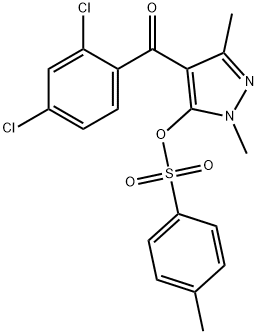Uses
Pyrazolynate is a 4-benzoyl pyrazole molecule used for
the selective control of annual and some perennial grass and broadleaf weeds in paddy rice in the Far East (as Sanbird) (20).
Definition
ChEBI: Pyrazolynate is a member of the class of pyrazoles that is 1,3-dimethylpyrazole which is substituted at positions 4 and 5 by 2,4-dichlorobenzoyl and p-tosyloxy groups, respectively. It is an obsolete proherbicide (via hydrolysis of the tosylate group to afford the corresponding 5-hydroxypyrazole), that was used to control weeds in rice paddy fields. It has a role as a proherbicide, an EC 1.13.11.27 (4-hydroxyphenylpyruvate dioxygenase) inhibitor, an agrochemical and a carotenoid biosynthesis inhibitor. It is a member of pyrazoles, a tosylate ester, an aromatic ketone and a dichlorobenzene.
Metabolic pathway
Hydrolysis of pyrazolate (DTP) in buffer solutions and
in artificial gastric and intestinal fluids proceeds
predominantly through base- and acid-catalyzed
processes in the regions above pH 7 and below pH 3,
respectively, whereas both processes occur between
pH 3 and pH 7. The hydrolysis products are p-
toluenesulfonic acid and 4-(2,4-dichlorobenzoyl)-1,3-
dimethyl-5-hydroxypyrazole. The metabolism study of
DTP in fish, rats, plant, soils, and soil microorganisms
shows that the metabolites in these systems are
mostly derived from the herbicidal entity of pyrazolate
resulting from N-demethylation and hydroxylation
followed by further oxidation of the methyl group of the
pyrazole ring and the cleavage of the carbonyl linkage
(see Nakagawa et al.).


